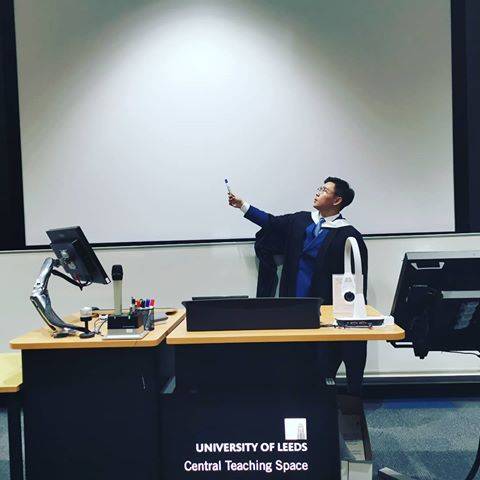沟通之前:希望您能花,三到五分钟的时间,观看我们的视频,对我们的能力,有一个初步判断。
艾米丽卡尔艺术与设计大学毕业照展示

加州的公立艾米丽卡尔艺术与设计大学和学院可能很快就会被要求为艾米丽卡尔艺术与设计大学的大学生提供在线艾米丽卡尔艺术与设计大学课程的学分,包括大量的开放式在线艾米丽卡尔艺术与设计大学课程,或MOOC——此举可能从根本上改变高等教育格局。
TS无法注册超额订阅类,以获得不属于其机构的在线艾米丽卡尔艺术与设计大学课程的学分。
3月13日提出这项法案的州参议员达雷尔·斯坦伯格说:“任何艾米丽卡尔艺术与设计大艾米丽卡尔艺术与设计大学的大学生都不应被剥夺完成学业的权利,因为他们无法在毕业所需的艾米丽卡尔艺术与设计大学课程中获得一个席位。
这不是为了技术的缘故。
”加州的三个公立高等教育系统——加利福尼亚艾米丽卡尔艺术与设计大学、加利福尼亚州立艾米丽卡尔艺术与设计大学和加利福尼亚社区学院——多年来严重削减了预算,这意味着成千上万的艾米丽卡尔艺术与设计大学的大学生被拒于核心艾米丽卡尔艺术与设计大学课程之外。
根据被称为参议院520法案的立法,2012年秋季,加州112所社区学院中近90%的艾米丽卡尔艺术与设计大学的大学生报告了艾米丽卡尔艺术与设计大学课程等待名单,平均每所艾米丽卡尔艺术与设计大学有7000名艾米丽卡尔艺术与设计大学的大学生在等待名单上。
而加州州立艾米丽卡尔艺术与设计大学的16%的艾米丽卡尔艺术与设计大学的大学生在标准四年内就能拿到艾米丽卡尔艺术与设计大学学位,这主要是因为他们无法注册毕业所需的艾米丽卡尔艺术与设计大学课程。
根据新的立法,来自三个系统的一个教师领导小组将制定一份50个订阅量最大的入门艾米丽卡尔艺术与设计大学课程的清单,并考虑哪些在线艾米丽卡尔艺术与设计大学课程有资格参加。
这个平台将花费大约1000万美元来创建,它将允许艾米丽卡尔艺术与设计大学的大学生访问免费的MOOC或低成本的在线艾米丽卡尔艺术与设计大学课程。
这些艾米丽卡尔艺术与设计大学课程只适用于那些无法在其院校注册类似艾米丽卡尔艺术与设计大学课程的艾米丽卡尔艺术与设计大学的大学生。
美国教育委员会(ACE)负责教育成就和创新的副主席凯西·A·桑迪恩(Cathy A Sandeen)告诉《艾米丽卡尔艺术与设计大学世界新闻》:“我们很高兴加州和其他地方正在认真考虑其他形式的潜在艾米丽卡尔艺术与设计大学学分。
”几十年来,为了推荐艾米丽卡尔艺术与设计大学学分,对军事和工作场所的艾米丽卡尔艺术与设计大学课程和经验进行了严格的评估。
但是她补充说,网络教育不应该取代传统艾米丽卡尔艺术与设计大学的作用。
关系应该能够决定是否接受学分推荐,校园内的学术决策应该由艾米丽卡尔艺术与设计大学的学校及其教职员工做出。
“过去网上在艾米丽卡尔艺术与设计大学学习由于质量低下,在某些情况下是欺诈性的艾米丽卡尔艺术与设计大学课程设置而受到怀疑。
然而,据《世界艾米丽卡尔艺术与设计大学新闻》报道,美国一些最负盛名的艾米丽卡尔艺术与设计大学的一系列网络活动改变了人们对网络教育的看法。
但是一些批评者表示担心,网络在艾米丽卡尔艺术与设计大学学习还没有出现足够长的时间,以至于我们不知道是否T确实有资格参加传统的课堂在艾米丽卡尔艺术与设计大学学习。
斯坦伯格在宣布该法案的新闻发布会上承认了这些顾虑,并称该立法并非旨在“替代校园艾米丽卡尔艺术与设计大学教学”。
他说:“这是为了帮助艾米丽卡尔艺术与设计大学的大学生。
”如果我们没有利用我们州的技术进步,我们就会犯一个大错误。
“加州艾米丽卡尔艺术与设计大学教师协会,代表加州州立艾米丽卡尔艺术与设计大学23个校区的系统,支持斯坦伯格为所有艾米丽卡尔艺术与设计大学的大学生提供入学机会的承诺。
d坚称,他们“希望维持学术信誉,提供可获得的、高质量的公共教育,而不是追逐私营部门的最新潮流”。
但是像Coursera和edX这样的数百万美元的网络计划是Stan等机构去年推出的。
福特和哈佛艾米丽卡尔艺术与设计大学指出,网上教育不仅仅是一时的时尚。
斯坦福艾米丽卡尔艺术与设计大学Coursera的共同创始人达芬·科勒(Daphne Koller)说,高质量艾米丽卡尔艺术与设计大学课程的提供“反映了人们对网络在艾米丽卡尔艺术与设计大学学习看法的巨大变化”。
NGE反映了技术的使用。

In a book published in 1968, two Belgian academics identified five different types of university models: Anglo-Saxon, German, American, French and Soviet.
Their ideas can be reduced to the following extremely short synthesis: the Anglo-Saxon model provides the individual with a way to realise him- or herself through learning; in the German model learning serves the truth; the American model sees learning as being about human progress.
In the two remaining models, the French and the Soviet, learning serves the needs of existing power structures.
As a French academic, my first reaction could have been taken straight out of an Asterix cartoon: “They are crazy, the Belgians”.
But I do realise that our Belgian colleagues are so much better placed than we are to form a synthetic and comparative view of university systems.
So after some thought and with my point of comparison defined as 1968, it became clear that this analysis is quite precise in historical terms.
There are actually not very many people, not even among academics, who know that the French Revolution suppressed traditional universities in 1793, and that Napoleon confirmed the new university system and placed it at the service of la nation with its essential mission being to provide professional training.
Universities were replaced by grandes écoles – including schools of engineering, military training, medicine, chemistry and law – all in the service of the state.
Only two traditional faculties remained: faculties of letters and faculties of science.
Their essential mission was to train teachers who, in turn, would train little French boys in the lycées (upper secondary) – girls were only admitted to the grandes écoles at a very late stage – and prepare them for Napoleonic schools.
So the system was perfectly coherent and self-contained.
Napoleon’s université impériale took the place of a national ministry of education until it was replaced by the ministry of public instruction during the republic.
In this way ‘university’ came to stand for the higher education sector of the regional administrative units known as ‘academies’ (as they are still known), at the head of which the government appoints a high-level administrator with the title of recteur.
The French recteur is in charge of all types of education: primary schools, secondary schools and tertiary-level education.
The académie awards the title of ‘university’, but this does not relate to any unified structure.
So, on the one hand, rectors manage the finances and personnel issues at universities while, on the other, faculties and their deans manage pedagogical issues and now also research.
Meanwhile, the schools of medicine, law and, later, pharmacy preferred to be known as faculties, as this sounded more prestigious in international terms and corresponded better to the development of research at these institutions.
But the presence of several such faculties in any given city does not necessarily lead to the creation of a university.
The rector remains the administrator appointed by Paris who has an overview of all areas of education, and the deans, elected by their peers, enjoy a wide measure of autonomy, although within the financial limits set by the ministry.
The large majority of university personnel are civil servants.
The traditional grandes écoles, structured to meet the needs of the large corps de l’état, are essentially professional education institutions that enjoy wide autonomy and are usually linked to ministries other than the national Ministry of Education.
They have increasingly included the large (and subsequently the less large) schools of commerce that are structured in much the same way, but are almost all under the auspices of chambers of commerce and not the national Ministry of Education.
French system is very differentFrom this it becomes clear that the French system of higher education differs in every way from the systems found in all the other countries surrounding France.
Even countries that have been under strong Napoleonic influence, such as Spain or Italy, have maintained traditional universities with an elected rector, while polytechnic universities contain the equivalent of the grandes écoles for engineers or administrators.
In this historical perspective it is easier to understand the shock that occurred in France at the end of the 1960s: it was the result, on the one hand, of the demographic explosion in the number of young people who demanded enrolment in higher education and, on the other, of the implementation of a new law, which introduced new structures according to which universities could elect their own presidents.
The first shock, that of student demographics, resulted in immense efforts being made by faculties of science and letters and, to a lesser extent, of law and economics, to overhaul their curricula completely in order to cope with the influx of students.
It was no longer a question of concentrating on the training of future teachers, as it had been earlier, but of diversifying courses to make them more professional and to respond to the need to prepare students for different jobs.
All of this was done on a limited budget.
In the light of limited funding, the constraints imposed (no changes were made around student selection and student rights) and criticism of institutions’ lack of contact with civil and economic society – contact that was normally reserved for the grandes écoles) – this proved a success.
The second shock, however, came as a result of the ‘Edgar Faure’ law, which introduced genuine universities.
It had disastrous consequences: the faculties embraced the new structures and under the fallacious but then famous pretext of ‘small is beautiful’, they set themselves up as universities by instituting haphazard alliances; law and medicine here, letters and law there.
In many cases they simply set up on their own.
In this way, in the majority of our cities in the provinces (not to mention Paris) the faculties split into two, three, even four separate universities.
It is not worth elaborating on the consequences of this state of affairs: a lack of visibility and confusion on the national as well as international level, not to mention sterile rivalries among universities in the same location and the multiplication of identical job functions, leading to a lack of efficiency and to funding problems.
Unfortunately, this state of affairs is impossible to change easily.
Even with the best of wills and when people are persuaded of the argument about how inefficient these divisions are, a university president cannot lightly take the risk of attempting to merge with one or two other universities since a merger will always be seen internally as being advantageous only to the other institutions involved and will mean the president’s power is diminished.
Few mergers have so far been completed; the present powers of the presidents are far too strong and strategic.
Now and again, a merger project is advertised.
There are the ‘PRES’ structures, which bring universities and research institutions together in clusters, but they risk cementing divisions instead of minimising them.
University reformsAnd yet this question is scarcely addressed in the swelling debate on current university reforms in France, regardless of the fact that it is one of the fundamental issues if one wants to reinstate some sort of order in the French higher education system, and to align French institutions with the great universities throughout the world.
The main objection to regrouping France’s many institutions is that it would result in huge universities.
This is true, but one can imagine several solutions along the lines of those practised elsewhere and there are multiple examples: the University of London, the Complutense University of Madrid and the University of California are all enormous institutions in terms of sheer numbers.
But they have managed to adapt their forms of governance.
In essence, these forms of governance are based on a definition of the respective strengths of their various components and a decentralisation of central power (whether rector or president) to faculties or their equivalents, which are situated on different campuses.
A rector or president should in essence be responsible for general policy, institutional planning, global inter-university relations – with the professional world and with international partners – and long-term decision-making.
They should not get involved in things, such as evaluating academic competence, that are outside their remit (except within their own academic field, of course) or research issues.
That should be what the deans or heads of departments do since they are responsible for the functioning of faculties or departments.
It is vital that France find the regulatory and financial means to encourage or oblige universities at major locations to merge into large, universal and decentralised institutions.
The law should reserve the title of ‘university’ (or ‘research university’ as some countries abroad term it) for institutions that bring together all the major basic disciplines in education and research in large faculties or schools.
This reunification may be difficult, but it is inevitable.
It could also involve the grandes écoles which call themselves ‘graduate schools’, as they benefit from what universities do.
Unfortunately, the new law has completely missed this point.
Furthermore, the new law has given greater powers to presidents in areas that should not be theirs, such as the selection of teaching staff.
All this law does is to replace the present system of national centralisation, with all its flaws as well as its strengths, with an internal centralisation.
This risks creating a more inefficient system, which will merely lead to a reinforcement of local competition.
* Jean-Marie Boisson is professor emeritus in the economics faculty of the University of Montpellier.
A longer version of this article has been published in the Journal of European Higher Education Area, March 2012, under the title “Why Do So Many French Universities Wear a Number? Some reflections on the recent (hi)story of French universities system".
| 案例展示 |
|---|
.jpg) 韩国鲜文大学学生毕业-手持证书毕业照 |
.jpg) 昆士兰大学学生毕业-手持证书毕业照 |
.jpg) 香港浸会大学毕业证学生毕业-手持证书毕业照 |
.jpg) 爱荷华大学学生毕业-手持证书毕业照 |
.png) 邓迪大学学生毕业-手持证书毕业照 |
.jpg) 加州大学伯克利分校学生毕业-手持证书毕业照 |
.jpg) 韩国成均馆大学学生毕业-手持证书毕业照 |
.jpeg) 罗格斯大学-新泽西州立大学学生毕业-手持证书毕业照 |
.jpg) 英国谢菲尔德哈勒姆大学学生毕业-手持证书毕业照 |
.jpg) 雪城大学学生毕业-手持证书毕业照 |
.jpg) 韩国外国语大学学生毕业-手持证书毕业照 |
.png) 新加坡国立大学学生毕业-手持证书毕业照 |
.jpg) 香港城市大学学生毕业-手持证书毕业照 |
.jpg) 香港中文大学学生毕业-手持证书毕业照 |
.jpg) 南加州大学学生毕业-手持证书毕业照 |
.jpg) 香港中文大学学生毕业-手持证书毕业照 |
.jpg) 韩国成均馆大学学生毕业-手持证书毕业照 |
.jpg) 新加坡南洋理工大学学生毕业-手持证书毕业照 |
.jpg) 邓迪大学学生毕业-手持证书毕业照 |
.jpg) 都柏林大学学生毕业-手持证书毕业照 |
.jpg) 皇家墨尔本理工大学学生毕业-手持证书毕业照 |
.jpg) 新加坡国立大学学生毕业-手持证书毕业照 |
.jpg) 梨花女子大学学生毕业-手持证书毕业照 |
.jpg) 伊利诺伊大学厄巴纳-香槟分校学生毕业-手持证书毕业照 |
.jpg) 伍伦贡大学学生毕业-手持证书毕业照 |
.jpg) 俄克拉荷马大学学生毕业-手持证书毕业照 |
.jpg) 曼彻斯特大学学生毕业-手持证书毕业照 |
.jpg) 卢顿大学学生毕业-手持证书毕业照 |
.jpg) 密歇根州立大学学生毕业-手持证书毕业照 |
.jpg) 曼彻斯特大学学生毕业-手持证书毕业照 |
.jpg) 加拿大约克大学学生毕业-手持证书毕业照 |
.jpg) 卡内基梅隆大学学生毕业-手持证书毕业照 |
.jpg) 日本创价大学学生毕业-手持证书毕业照 |
.jpg) 加拿大温莎大学学生毕业-手持证书毕业照 |
.jpg) 新南威尔士大学学生毕业-手持证书毕业照 |
.jpg) 高丽大学学生毕业-手持证书毕业照 |
.jpg) 埃迪斯科文大学学生毕业-手持证书毕业照 |
.jpg) 纽约大学学生毕业-手持证书毕业照 |
.jpg) 牛津大学学生毕业-手持证书毕业照 |
.jpg) 公州大学学生毕业-手持证书毕业照 |
.jpg) 利物浦大学学生毕业-手持证书毕业照 |
.jpg) 西安大略大学学生毕业-手持证书毕业照 |
.jpg) 会计师学生毕业-手持证书毕业照 |
.jpg) 意大利罗马大学学生毕业-手持证书毕业照 |
.jpg) 普渡大学学生毕业-手持证书毕业照 |
.jpg) 昆士兰科技大学学生毕业-手持证书毕业照 |
.jpg) 考文垂大学学生毕业-手持证书毕业照 |
.jpg) 爱知工业大学学生毕业-手持证书毕业照 |
.jpg) 宾夕法尼亚大学学生毕业-手持证书毕业照 |
.png) 亚利桑那州立大学学生毕业-手持证书毕业照 |
